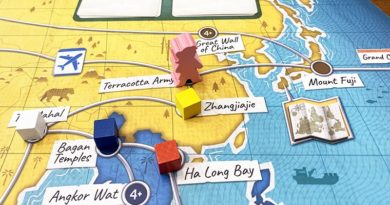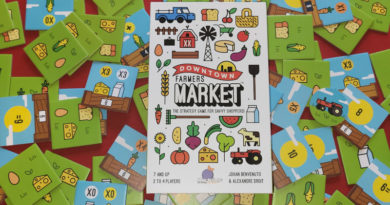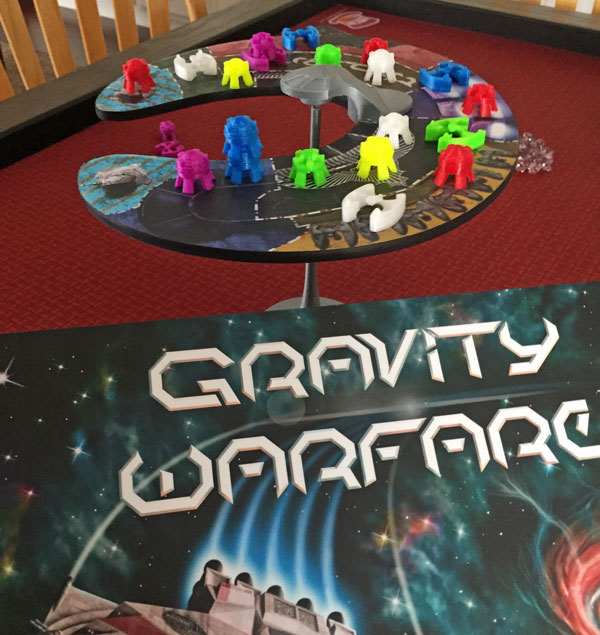Tiny Towns board game review
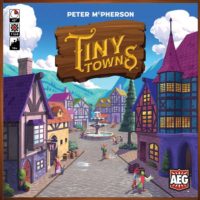
When you set out to build a city, you think big.
When you set out to build a town, you think a little bit less big.
But we imagine you still wouldn’t think about building a town as small as you do in Tiny Towns.
Tiny Towns is a new board game published by AEG that has players constructing their own towns on little 4×4 grids. The variety of buildings to place in those towns is huge. But the area is small.
So you’ll have to make the most of your limited space to cram in as many valuable buildings as you can.
Are you up to the task?
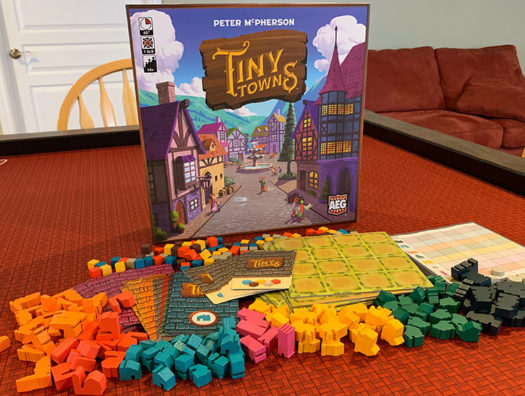
How to play Tiny Towns
Tiny Towns is a very simple game to teach and learn how to play. The only tricky part is the scoring.
To begin, every player gets their own player board — which is a 4×4 town grid.
Then the building cards are laid out. There’s one building card that’s in every game — the Cottage. The rest are randomly drawn from their groups so every game is played with a unique set of 7 buildings.
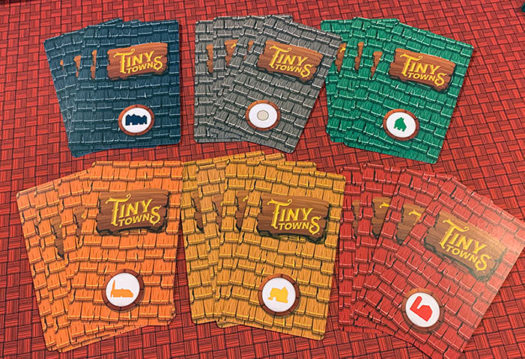
There are 4 different building cards in each category. For example, one category (the orange building shape with a steeple) includes an Abbey, a Chapel, a Cloister, or a Temple. Players shuffle each group of 4 cards and draw one to put into play for the game. The rest are put back in the box.
Then each player draws 2 Monument cards, looks at them both, and selects 1 Monument card to keep face down. This is a building that only they can construct in their town. It will provide either a special ability, additional scoring, or both.
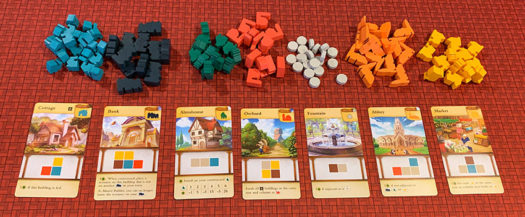
Playing
Players take turns being the Master Builder, but every player plays on everyone’s turn.
The Master Builder names a resource and every player takes one of those matching resource cubes. They represent Wood, Wheat, Brick, Stone, and Glass. Then each player places the resource cube on any empty space in their town.
If a player has formed a shape in their town with resources that match a building shape, they may construct that Building. To do so, they remove the resource cubes from their board and place that Building structure on one of the spaces the resource cubes were on.
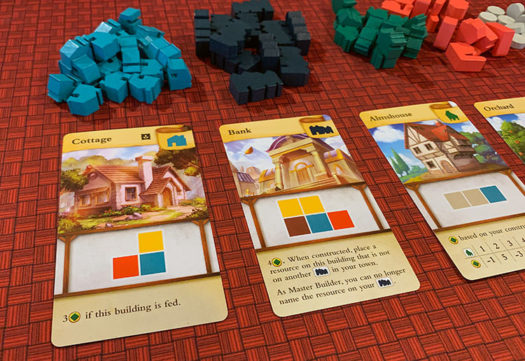
For example, if they’ve built a Feast Hall with 2 wood and 1 glass in a line, they may place the green Feast Hall building in one of the 3 spaces vacated by the wood or glass resource cubes.
The same applies for their unique Monument building. Once they’ve completed the matching formation of resources on their Monument card, they can announce it, place their Monument card face up next to their board, remove the cubes, and place their Monument building in one of those spaces.
After players have placed their resource cube and chosen to construct buildings, the Master Builder designation goes on to the next player to the left who then choose a resource type.
When a player’s town is filled with resources and they cannot or choose not to construct any buildings, their town is completed. The rest of the players continue taking turns. If only 1 player is left, that player can continue naming resources, taking them, and constructing buildings until their town is complete.
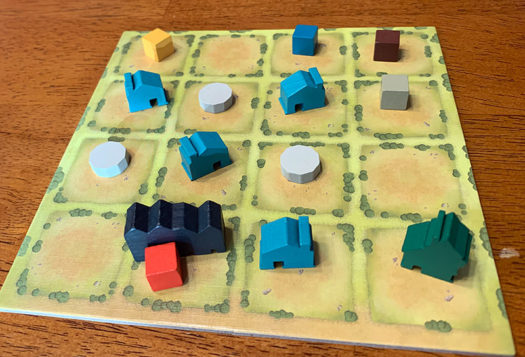
Scoring
Once all players have completed their towns, the game ends and players calculate scores.
All remaining resource cubes are removed from player boards. Each empty square in a town will score -1 point.
The rest of the scoring depends entirely on which Buildings are in play for that game. Each building card describes how it will score at the end of the game.
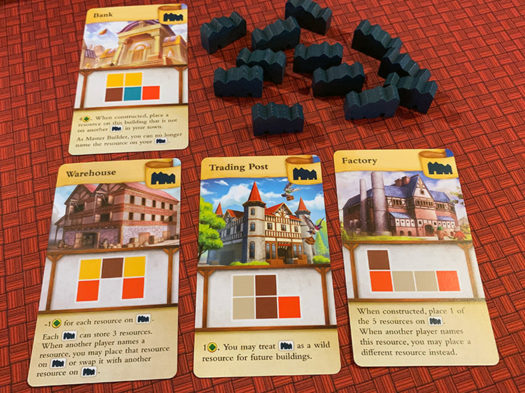
For example, the Cottage, which is in every game, will score 3 points if it is “fed”. How a town gets fed will depend on if the Farm, Granary, Greenhouse, or Orchard is in play. Having a Farm in town will feed up to 4 Cottages anywhere in the town. Whereas a Granary will only feed Cottages in the immediate 8 spaces around it.
To make adding up scores from the various 7 building types easier, the game comes with scoring sheets. Players move down building type by building type and record their score for that type. Then they tally their scores at the bottom and the player with the most points wins!
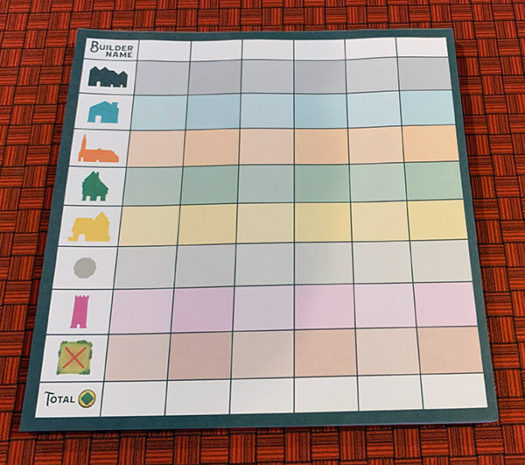
There’s also an option to play Tiny Towns solo.
Rather than having a Master Builder choose which type of resource to place in your town, there’s a resource card deck to use. The player draws a card that will determine which resource to place. At the end of the game, the player checks their final score against a chart in the rule book to see how well they did.
Can the whole family enjoy playing Tiny Towns?
We’ve been very pleasantly surprised by Tiny Towns.
To be honest, when we first saw it, we didn’t expect too much. But when we finally got it to the table and played it, we realized there was more depth to the game than we’d initially suspected. And we couldn’t stop ourselves from playing again right after!
There are a number of things that draw us back to playing the game.
The first is the puzzle-like nature of the game play.
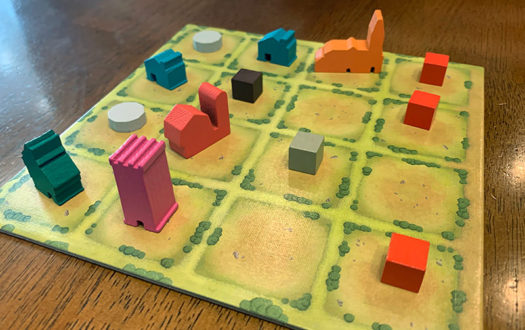
Each building requires different resources configured in different ways on your player board. And with 7 different building types in each game, there are plenty of configurations to make. So figuring out which resources you want and where to place them is like piecing together a puzzle.
The game also has a Tetris-like feel to it with how the building shapes are configured. You have your standard lines and a square. But you also have your elbow pieces and small “T”s.
We’re really enjoyed finding ways to fit the configurations around our boards. Because once you place a resource, the only way it will be removed is to complete a building configuration it can be used in.
And once you do remove resource and construct a building in their vacated space, you now have a permanent building that you’ll need to work around as you place new resources for new buildings.
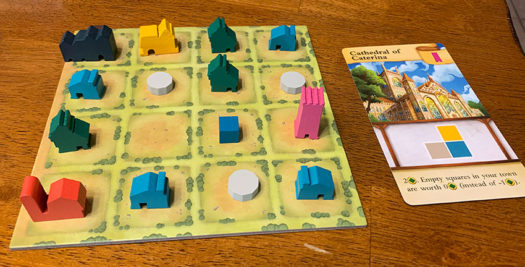
As the game progresses, the choices get tougher.
It’s in those waning moments that which resources get called out by the Master Builder make a big difference in how your town finishes out. While there isn’t any direct interaction between players, there is a big factor of indirect interaction. That’s because the Master Builder calls out which resource must be added to everyone’s town.
So if a Master Builder calls a resource you don’t need/want, you’ll be squirming in figuring out where to place it so it doesn’t mess up your places too much.
The next huge plus for Tiny Towns is the variable game set up and scoring.
One of my favorite board games is Kingdom Builder. I love it because every game includes a different board configuration, different mix of special abilities to work with, and different end-game scoring methods. Thus, every game is a unique mental challenge on how to place pieces to maximize in that specific situation.
Likewise, Tiny Towns has immense replay value because every game will present a unique set of buildings to work with. There are 4 different buildings in each category, but only 1 of each category is in play in a game. So the possible mixtures of building is huge.
And with each building scoring in different ways, players will construct their towns differently every game!
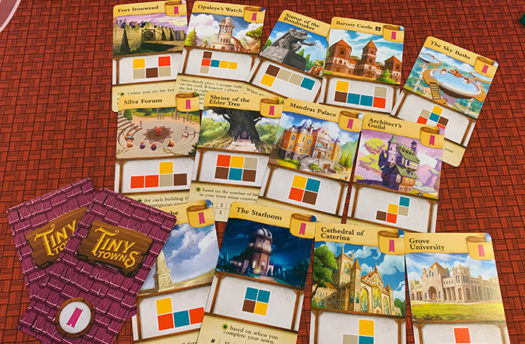
What we’ve found though is that we like to play back-to-back games with the same 7 buildings. That way the first game is kind of like a learning game of that particular mix of buildings. Then we go into the second game better understanding how the scoring of those buildings work together. Our strategies will change and we’ll dive into it again.
Of course, the variable scoring each game and the way buildings are constructed means Tiny Towns may not be suited for young players. For a game with simple rules, there’s plenty of thinking and strategizing required.
The last 2 points we’ll mention that we love are the player count and the simultaneous play.
Up to 6 players can play Tiny Towns and that’s perfect for our family!
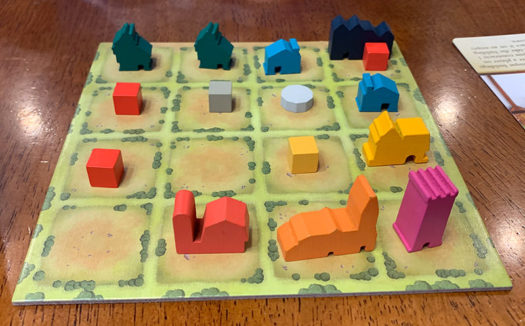
And it’s also great for playing with friends when we have more than 4 players. So many games are made for up to 4 players, that as soon as you have a 5th player, you have to scrap playing all those games. Well, Tiny Towns plays fantastically and in the same amount of time at any player count.
That’s because of the simultaneous play!
Players aren’t sitting around waiting for their turn to do something. Every player is active the whole game.
Even when it’s not you’re turn, you’re still gaining and placing resources in your town. And if you make the right configurations, you may also construct buildings. You just have to wait for your turn as the Master Builder to name the resource.
And fun games with low player downtime are a huge hit in our home.
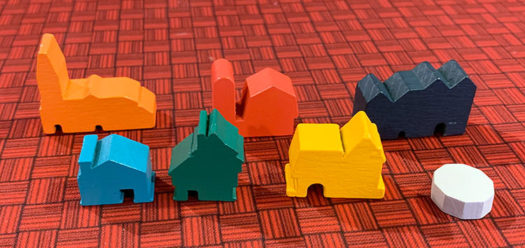
How does Tiny Towns score on our “Let’s Play Again” game meter?
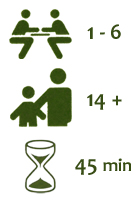 If you haven’t already caught it in our review, Tiny Towns scores high on our “let’s play again” game meter. And when it’s mom calling out for another play, it’s a home run.
If you haven’t already caught it in our review, Tiny Towns scores high on our “let’s play again” game meter. And when it’s mom calling out for another play, it’s a home run.
Tiny Towns has gone over well in our family, with our friends, and at work lunch breaks. And I predict many more games ahead.
I don’t foresee ever playing every possible combination of building types, but I’m sure we’re going to see a lot.
If you’re looking for an easily approachable board game with puzzle-like thinking required, definitely give Tiny Towns a go!
We’d like to thank AEG for a review copy of Tiny Towns.



